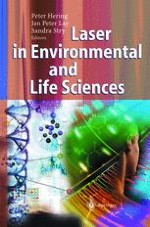2004 | OriginalPaper | Chapter
Laser-Induced Fluorescence (LIF) Spectroscopy for the In Situ Analysis of Petroleum Product-Contaminated Soils
Authors : R. H. Schultze, M. Lemke, H.-G. Löhmannsröben
Published in: Laser in Environmental and Life Sciences
Publisher: Springer Berlin Heidelberg
Included in: Professional Book Archive
Activate our intelligent search to find suitable subject content or patents.
Select sections of text to find matching patents with Artificial Intelligence. powered by
Select sections of text to find additional relevant content using AI-assisted search. powered by
Laser-induced fluorescence (LIF) spectroscopy is of great importance for environmental monitoring. Besides outstanding sensitivity and good selectivity, particular advantages of the LIF technique include the capabilities for in situ analysis and remote sensing. The major advantage of in situ LIF measurements is the lack of sampling and clean-up procedures preceding the analysis. Such procedures are error-prone, time consuming and expensive. The contamination of water or soil with petroleum products (oils) represents a major environmental risk. Since most petroleum products exhibit distinct native fluorescence it is promising to apply LIF analysis to the detection and characterization of oils in environmental coinpaitments. The LIF investigation of oil-polluted waters with LIDAR and fiber optical sensing techniques is well advanced and appropriate instrumentation is commercially available. The employment of fluorescence techniques for in situ analysis of soil contaminations has received considerable attention only during the last decade. The combination of LIF instrumentation with geotechnical drilling equipment for real-time subsurface detection of oil pollutions, as pioneered by Lieberman et al. (Lieberman 1990), and field demonstrations have recently been described in detail in technology reviews and a monograph (Hart 1997, Lieberman 1998, Balshaw-Biddle 2000). Importantly, LIF-based techniques find increasing regulatory acceptance and have been verified as field screening methods for petroleum products by the US Environmental Protection Agency (US-EPA). For assessment and control of the environmental damage imposed in Kuwait during the Gulf War LIF investigations play an important role in what may become the “biggest environmental remediation project ever attempted” (Shouse 2001, Quinn 1995). In Germany, various aspects of LIF analysis of soils have been addressed in works of, among others, Niessner et al., Schade et al., Marowsky et al., Zimmermann and Lucht (Baumann 2000, Schade 1996, Marowsky 2001, Zimmermann 1997, and references therein), as well as by our group (Löhmannsröben 1996, 1997, 1999, 2000).
